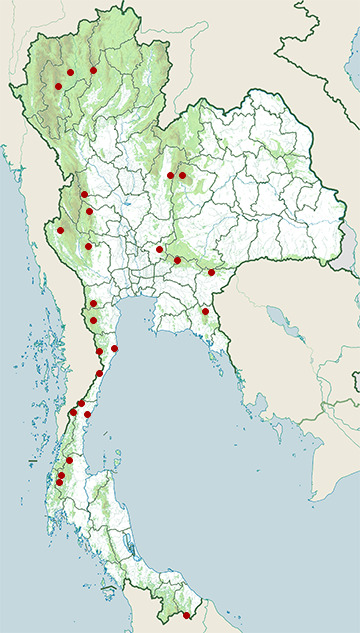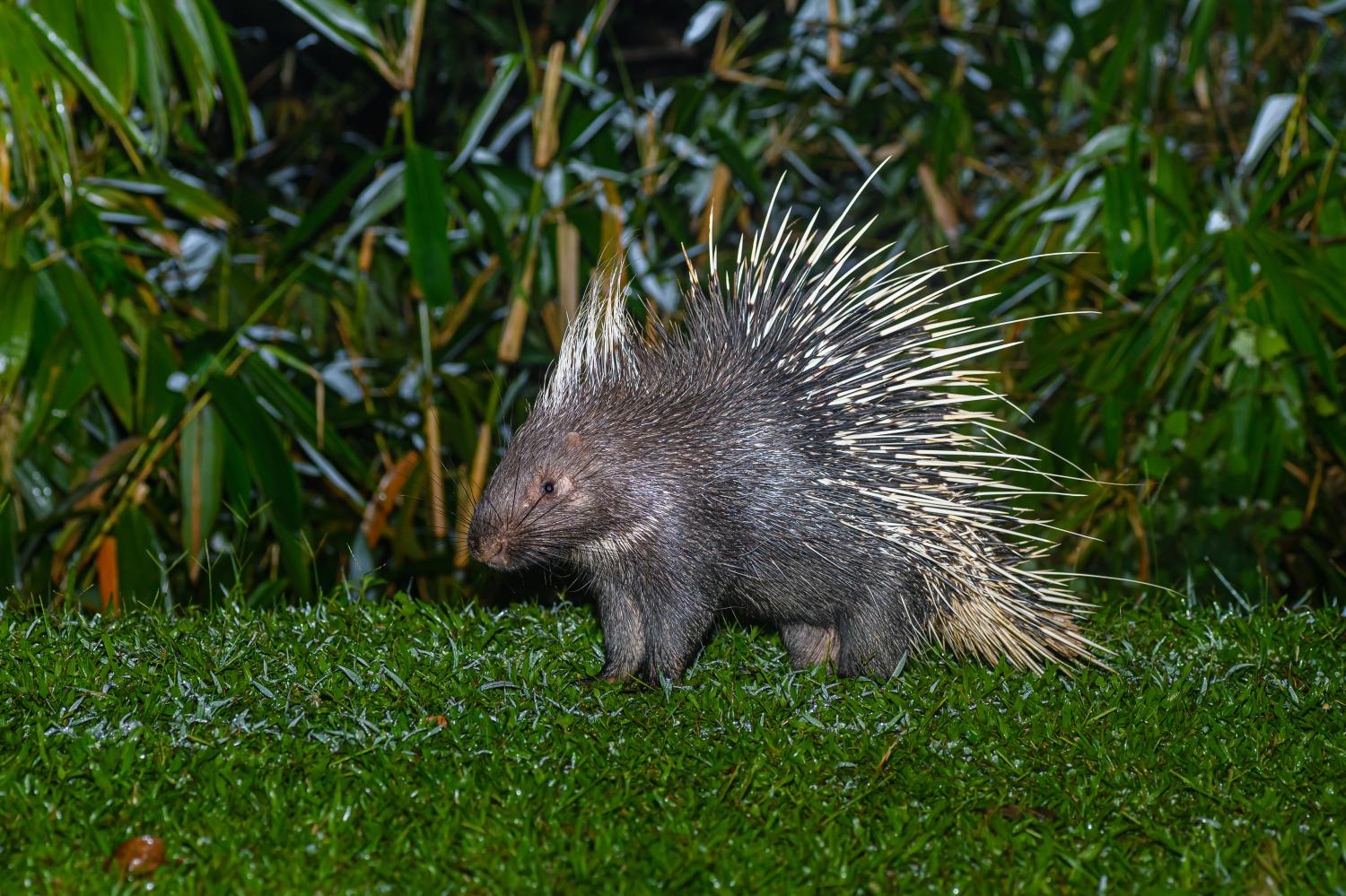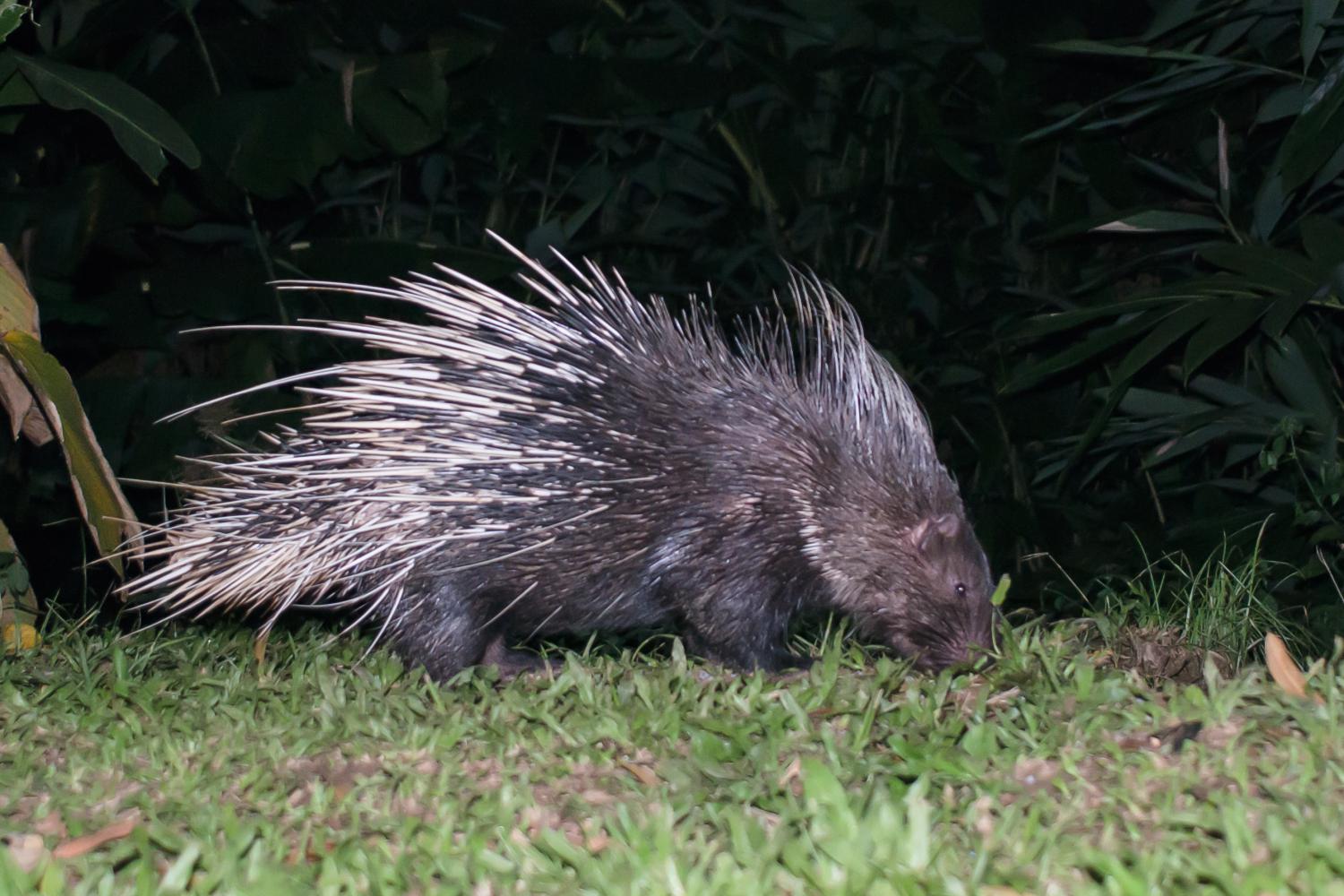Species of Thailand
Malayan porcupine
Hystrix brachyura
Carolus Linnaeus, 1758
In Thai: เม่นใหญ่แผงคอยาว
The Malayan porcupine or Himalayan porcupine (Hystrix brachyura) is a species of rodent in the family Hystricidae. Three subspecies are extant in South and Southeast Asia.
Characteristics
It is a large and stout-bodied rodent covered with quills which are sharp, rigid structures. The quills are modified hair. Those on their upper body parts are rough with black with white or yellow stripes. The young's soft quills become hard as they enter adulthood. They have short, stocky legs covered in brown hairs which have four claws on the front and five on the hind legs. Both front and hind legs have smooth soles. The head and body measurement are around 56-74 cm and the tail is about 6–11 cm. They weigh around 10 kg-18 kg.
Distribution and habitat
The Malayan porcupine ranges from Nepal through north-east India (Arunachal Pradesh, Sikkim, West Bengal, Manipur, Mizoram, Meghalaya and Nagaland), to Bangladesh, central and southern China (Xizang, Hainan, Yunnan, Sichuan, Chongqing, Guizhou, Hunnan, Guangxi, Guangdong, Hong Kong, Fujian, Jianxi, Zhejiang, Shanghai, Jiangsu, Anhui, Henan, Hubei, Shaanxi, Gansu), throughout Myanmar, Thailand, Laos, Cambodia and Vietnam, through Peninsular Malaysia, to Singapore, Sumatra (Indonesia) and throughout Borneo (Indonesia, Malaysia, Sarawak and Brunei). It is also present on the island of Penang, Malaysia. It can be found from sea level to at least 1, 300 m asl.
It inhabits various types of forests and open areas near forests; it strays into nearby agricultural areas.
Behaviour and ecology
The Malayan porcupine is terrestrial and usually lives in small groupsThey often inhabit dens they have found near rocky areas or in the holes of trees or root systems. They may also dig out and live in burrows, from which a network of trails penetrate into surrounding habitat. They can be found in all forest types up to 1500 m altitude.
The Malayan porcupine forages at night and rests during the day. It may live singly or in pairs. It can swim and gnaw. The sow usually delivers a single pup at a time, but delivering two pups has also been recorded. The gestation period is about 90 to 112 days. Their maximum longevity is about 27 years.
Diet
They normally feed on roots, tubers, bark and fallen fruits. They also eat carrion, insects, and large tropical seeds such as belonging to Chisocheton cumingianus.
Conservation
The Malayan porcupine has been categorized as Least Concern on the IUCN Red List.
This article uses material from Wikipedia released under the Creative Commons Attribution-Share-Alike Licence 3.0. Eventual photos shown in this page may or may not be from Wikipedia, please see the license details for photos in photo by-lines.
Scientific classification
- Kingdom
- Animalia
- Phylum
- Chordata
- Class
- Mammalia
- Order
- Rodentia
- Family
- Hystricidae
- Genus
- Hystrix
- Subgenus
- Acanthion
- Species
- Hystrix brachyura
Common names
- English:
- Malayan porcupine
- Hodgson's porcupine
- Himalayan crestless porcupine
- Thai: เม่นใหญ่แผงคอยาว
Conservation status

Least Concern (IUCN3.1)
Photos
Please help us review our species pages if wrong photos are used or any other details in the page is wrong. We can be reached via our contact us page.
Range Map

- Chae Son National Park
- Chaloem Rattanakosin National Park
- Doi Inthanon National Park
- Doi Suthep - Pui National Park
- Hala-Bala Wildlife Sanctuary
- Huai Kha Khaeng Wildlife Sanctuary
- Huai Yang Waterfall National Park
- Kaeng Khoi District, Saraburi
- Kaeng Krachan National Park
- Kaeng Krung National Park
- Khao Dinsor (Chumphon Raptor Center)
- Khao Laem National Park
- Khao Sam Roi Yot National Park
- Khao Soi Dao Wildlife Sanctuary
- Khao Sok National Park
- Khao Yai National Park
- Khlong Saeng Wildlife Sanctuary
- Kui Buri National Park
- Mae Nam Phachi Wildlife Sanctuary
- Mae Wong National Park
- Pang Sida National Park
- Phu Khiao Wildlife Sanctuary
- Royal Chumphon Forest Park
- Sadeth Naikrom - Krom Luang Wildlife Sanctuary
- San Kala Khiri National Park
- Tat Mok National Park


